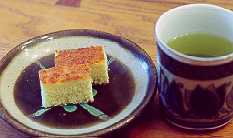HOME
PAGE 
CAKE
& SNACK
Kastella
Dorayaki 
Kompeitoh 
DRESSING 
GARDENING
GREEN
TEA
Varieties
Preparation 
When
and where
Benefits
PICKLES
Beer-zuke 
Hakumai-zuke 
Bettara-zuke 
NATTO
SUSHI
Rice
Nigiri-zushi
Hako-zushi
Temaki-zushi
Masu-zushi
History of Japanese Kastella goes back to 16th Century when Spanish missionaries baked their sponge cake at Nagasaki, a prosperous and popular port located on the west edge of Japan. "Kastella" is after Castile, the name of central regions of Spain. (Ferdinando II and his wife Isabella I, respectively the King of Aragon and Queen of Castile, are known to have supported Christopher Columbus.)
In its early history, Kastella was limited to only the high class society in Japan. Kastella gradually spread among merchants and samurai during the Edo era. It was in Meiji era, however, that Kastella became explosively popular among Japanese people.
 Modern Kastella is believed to have changed from the traditional ones.
The traditional method of making Kastella can still be found, however,
in some local areas in Japan, like Iwamura-cho in Gifu prefecture.
Modern Kastella is believed to have changed from the traditional ones.
The traditional method of making Kastella can still be found, however,
in some local areas in Japan, like Iwamura-cho in Gifu prefecture.
The recipe here is close to the modern version.
Material:
- 6 eggs
- 2 cup sugar (may be reduced to 1.5 cup for a less sweet cake. )
- 1.4 cup cake flour (low gluten flour, shifted)
- 2 scant tablespoon honey (do not exceed)
- 4 tablespoon warm water
- Dissolve honey in the warm water completely. Set aside.
- Combine sugar and eggs in a bowl. Beat at a high speed for 4 to 5 minutes, or until the whole mixture becomes smooth pale yellow, and a peak can be made.
- Add honey-water and beat for another half minute.
- Add shifted flour. Mix the whole by a wood spatula until smooth.
- Find a 50 square-inch baking pan, or an equivalent (approximately, 7 inch by 7 inch).
- Line the inside surface completely with aluminum foils.
- Pour the flour-egg mix into the baking pan.
- Bake for 45 minute at 375 degrees F (which is higher than the temperature normally used for cake baking). Check the cake by inserting a skewer to see if it comes back dry. If the skewer is clung with sticky mixture, bake 5 to 10 minutes longer. Keep in mind that, as the thickness of the cake increases (or decreased), the baking time becomes longer (or shorter). (See footenote) It is normal that surface of Kastella tends to become deep brown at this temperature and baking time length. Do not reduce the temperature in the middle of baking, or the center will sag.
- When cooled, lift the cake with the alminum foils from the baking pan. Wet the knife frequently to cut Kastella easily.
Footnote:
- If a larger baking pan is used
for the same amount of flour-egg mix, the height of Kastella decreases.
In this case the baking time must be decreased. If the bottom and side
of the baking pan are dark, the baking time length decreases also. So baking
time and temperature should be adjusted accordingly. (Never fill the baking
pan more than the middle level of the baking pan.)